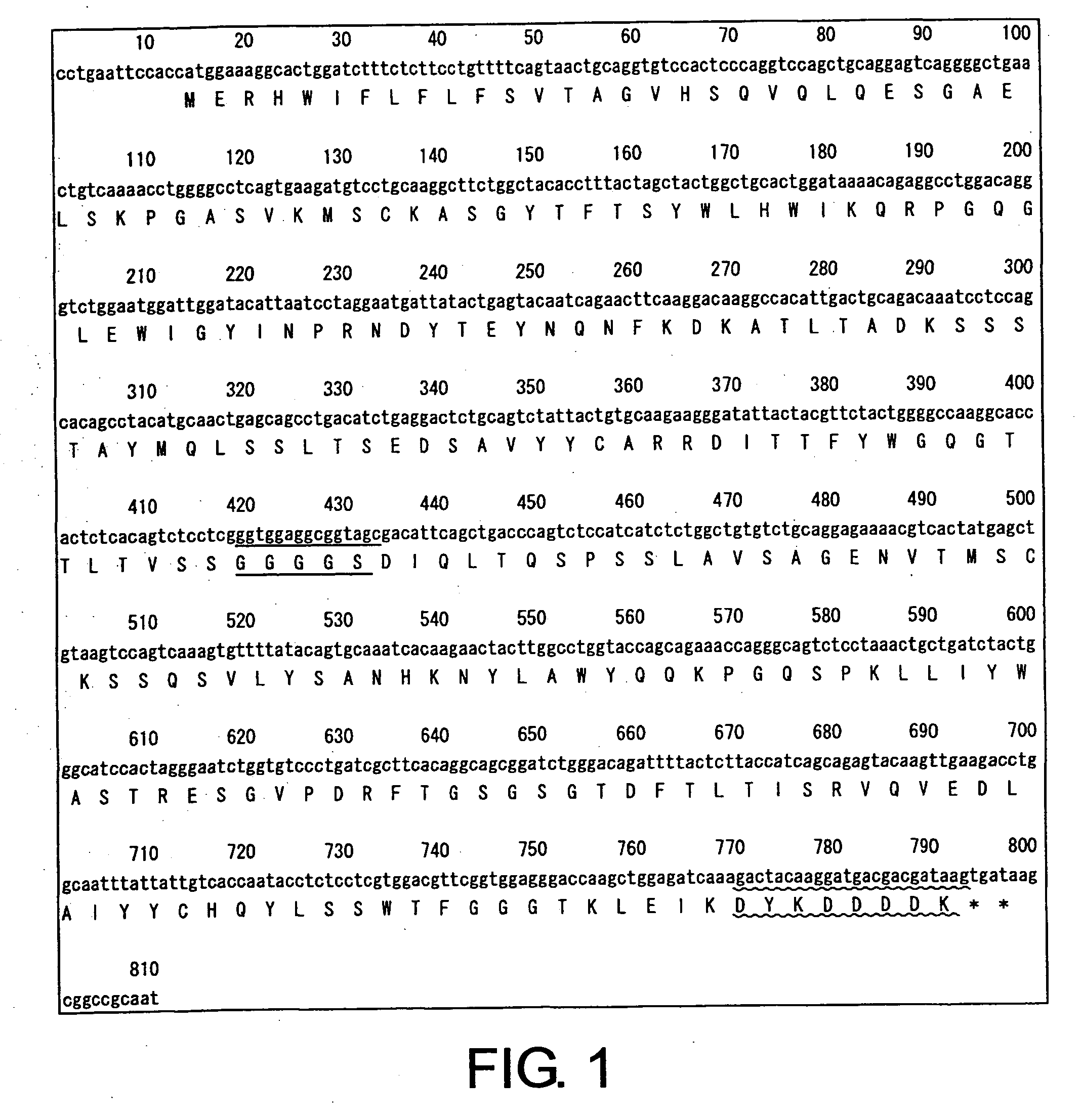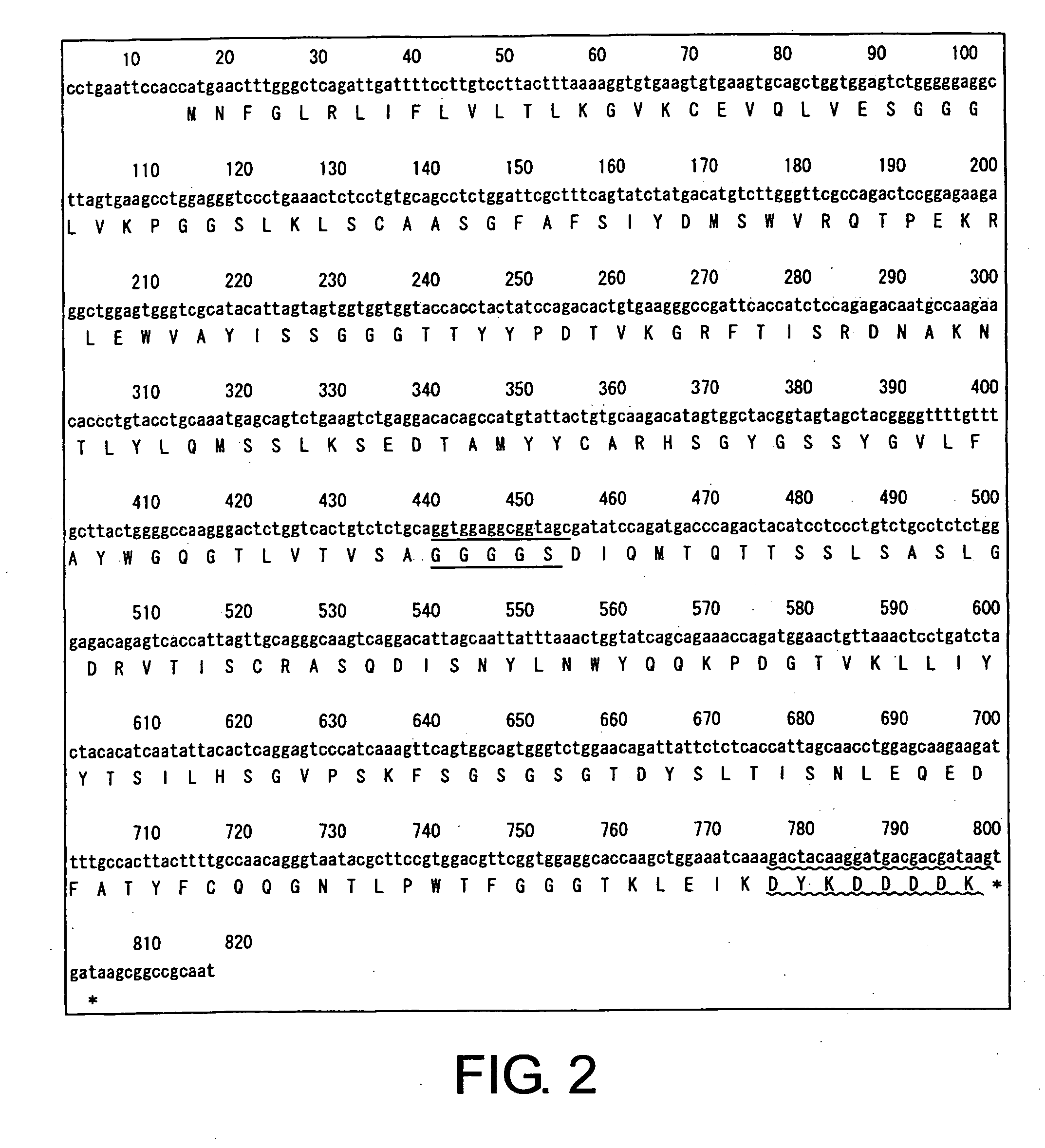Modified antibodies against cd22 and utilization thereof
a technology of cd22 and antibodies, applied in the field of antibodies, can solve the problems of not revealing the relationship between anti-cd22 antibodies and apoptosis-inducing activity, and their apoptosis-inducing activity has not been examined, and achieves the effect of large lymphoma effect and effective treatment and prevention
- Summary
- Abstract
- Description
- Claims
- Application Information
AI Technical Summary
Benefits of technology
Problems solved by technology
Method used
Image
Examples
example 1
Production of CD22 Diabody-Expressing Vectors
[0098] Based on previously known sequence information for two types of anti-CD22 antibodies, specifically LL2 (U.S. Pat. No. 3,053,873) and RFB4 (JP 2002501488-A), nucleotide sequences for each of the CD22 diabodies, in which the heavy-chain and light-chain variable regions are linked through a 5-mer linker, were designed (LL2 diabody and RFB4 diabody). Each of the diabody sequences are shown in FIG. 1 (SEQ ID NOs: 1 and 2) and FIG. 2 (SEQ ID NOs: 3 and 4) (linkers are indicated by underlines, and Flag-tags are indicated by wavy lines).
[0099] To synthesize cDNAs encoding the designed LL2 diabody and RFB4 diabody, twelve types of oligo-DNAs were produced for each of the diabodies (Espec Oligo Service). The sequences of the synthetic DNAs used are shown in SEQ ID NOs: 13 to 36. cDNAs encoding the diabodies were synthesized as described below. First, two of the oligo-DNAs each were mixed in appropriate combinations. Each mixture was subjec...
example 2
Purification of CD22 Diabodies
(1) Establishment of Cell Lines Expressing LL2 Diabody and Collection of Culture Supernatant
[0101] 20 μg of pCXND3-LL2 DB, linearized by cleaving with PvuI, was introduced into DG44 cells by electroporation, as described below. After washing DG44 cells twice with ice-cold PBS, they were suspended in PBS to a density of 1×107 cells / ml. 20 μg of the above-mentioned plasmid was mixed into the suspension, and subjected to electroporation (1.5 kV, 25 μFD). The cells were appropriately diluted, plated onto a 96-well plate, and cultured in the presence of G418 (GIBCO) at a final concentration of 500 μg / ml. Approximately 30 cell clones were selected from wells in which colonies had grown, and diabody expression levels in the culture supernatants were investigated by Western blotting. Clones showing diabody expression were expanded to use as LL2 diabody-overproducing cell lines. A confluent LL2 diabody-overproducing cell line in a T-175 flask was transferred ...
example 3
Confirmation of Binding of CD22 Diabodies to Lymphoma Cells
[0104] Purified LL2 diabody and RFB4 diabody were added to cells of the B-lymphoma cell line, Raji, in PBS containing 2% FCS and 0.02% NaN3 such that the final concentrations were 20 μg / mL and 8 μg / mL, respectively. After reacting on ice for one hour, anti-Flag M2 antibody was added to the mixture, and then reacted on ice for another one hour. The cells were washed and reacted with FITC-anti-mouse IgG on ice for 30 minutes. Diabody binding to the cell surface was measured by flow cytometry (EPICS ELITE, COULTER).
PUM
| Property | Measurement | Unit |
|---|---|---|
| temperature | aaaaa | aaaaa |
| body weight | aaaaa | aaaaa |
| body weight | aaaaa | aaaaa |
Abstract
Description
Claims
Application Information
 Login to View More
Login to View More - R&D
- Intellectual Property
- Life Sciences
- Materials
- Tech Scout
- Unparalleled Data Quality
- Higher Quality Content
- 60% Fewer Hallucinations
Browse by: Latest US Patents, China's latest patents, Technical Efficacy Thesaurus, Application Domain, Technology Topic, Popular Technical Reports.
© 2025 PatSnap. All rights reserved.Legal|Privacy policy|Modern Slavery Act Transparency Statement|Sitemap|About US| Contact US: help@patsnap.com



